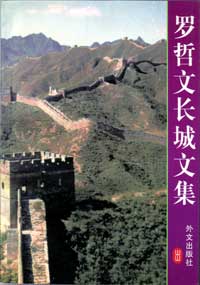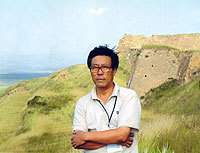NEW SCHOLARSHIP
Dedicated to Great Wall Conservation | China Heritage Quarterly
DEDICATED TO GREAT WALL CONSERVATION:
A PORTRAIT OF THREE CHINESE SCHOLARS
Cultural heritage conservation had a troubled history in Maoist China (1949-1978). Although the Chinese Ministry of Culture paid great attention to archaeology and cultural relics work in the 1950s and early 1960s, outside these fiefs neglect was often the kindest fate an ancient monument could be accorded. The Party waged an active onslaught against temples, walls and other ancient monuments as the physical embodiment of a denigrated feudal past. On occasion, the population was even mobilised to demolish these symbols of the past. The government's ideological modus operandi of 'weeding out the dross' (qu qi zaobo) of the past, and of 'allowing the past serve the present' (gu wei jin yong) did not sit squarely with the elitist private habits of collecting embraced by many of the Communist leaders, most notably Kang Sheng and Mao himself. Yet the campaign 'to destroy the Four Olds' (po sijiu, that is, 'old ideas, old culture, old customs and old habits'), a tenet of the Cultural Revolution that received further central government approval from Lin Biao, Mao's second-in-command, in August 1966, represented one of the most total efforts to destroy traditional culture launched by any ancient or modern society.
The depredations of the Cultural Revolution deeply affected all of those who, in the late 1970s and 1980s, sought to salvage what remained in its wake. Fortunately, the records of confiscation by Red Guards of private heirlooms and collections, which were then stored and sealed up in government warehouses, identified some objects for posterity, although many were pilfered from the storerooms—either by senior or well-connected government officials perusing for objects for their private collections, or, after the Cultural Revolution, by government and army agents, acting on behalf of the state, who channelled unclaimed objects onto the international market via Hong Kong, thereby laying a foundation for today's world market in Chinese antiquities.
Many of the impressive elderly generation of conservators active today, among whom retirees from the Palace Museum figure prominently, can still describe the concern for heritage which characterised the Republican period, the 1950s and the early 1960s. Born in 1924, Luo Zhewen, is one of China's leading scholars of ancient architecture, especially that of the Great Walls. (Fig. 1) In 1940, he became a student of Liang Sicheng (1901-1972), and later a member of Liang's Zhongguo Yingzao Xueshe (Chinese Architectural Society, 1929-1943), named for the Song dynasty treatise on ancient architecture titled Yingzao fashi. The society was a group of intellectuals devoted to the study, documentation and preservation of ancient Chinese architecture. Several foreign scholars, including the art historian Wilma Fairbank who conducted pioneering fieldwork at the Wu Liang Shrine in Shandong, were also involved with the group. In 1948, Luo graduated from the China Institute of Architecture, and in 1950 was assigned to academic and organisational work associated with ancient architecture and its conservation in the newly founded State Bureau of Cultural Relics.
The State Bureau of Cultural Relics (Guojia Wenwu Ju) had been established in November 1949, although there was a rudimentary 'cultural relics' organisation in Yan'an during the guerrilla war period. The bureau was mostly concerned with the establishment and administration of museums; it also maintained a control over archaeological finds, although archaeological work per se was initiated by the Chinese Academy of Science especially in the prior to the establishment of archaeology as a university-based discipline. Although in 1966 the organisation fell into a state of paralysis, it had already begun addressing the question of cultural heritage by classifying particular ancient monuments as protected sites. In 1961, for example, the State Council, at the recommendation of the bureau, issued China's first list of what were called 'Zhongdian Wenwu Baohu Danwei' (Key Cultural Relics Protection Units). The list comprised 180 sites, including three along the Ming dynasty Great Wall—Badaling, Shanhaiguan and Jiayuguan. Ironically, the walls of Xi'an were also included on the list, even though the dismantling of Beijing's city walls had begun in the 1950s.

Fig. 2 Cover of
A Collection of Essays on the Great Wall by Luo Zhewen, Beijing: Waiwen Chubanshe, 1996..This work is designed to appeal to both a scholarly and general readership.
Luo Zhewen was also engaged in early archaeological work conducted at the Badaling section of the Great Wall in the 1950s, and in the compilation of the first list of protected heritage sites. The Cultural Revolution brought his work to an end. It was only in 1973 that the State Council reactivated the Wenwu Ju, directly under its auspices, and renamed it the State Cultural Relics Enterprises Management Bureau (Guojia Wenwu Shiye Guanli Ju). In 1980, a separate organisation was set up by the State Council to supervise libraries, and in 1983 a further shuffling of cultural 'portfolios' brought this organisation under the Wenhua Bu (Ministry of Culture). In 1988, the organisation was renamed the Guojia Wenwu Ju (State Cultural Relics Bureau), the Chinese name it has retained to the present, although its official English name was changed in late 2003 to the State Administration of Cultural Heritage (SACH).
Luo Zhewen was little involved with such name shuffling. He was, however, sought out as someone with genuine knowledge applicable to preserving what were seen in the 1970s and 1980s as potential money-making monuments that might help kick-start a failed economy. At that time, the Badaling Great Wall site remained relatively inaccessible to tourists from Beijing, even though some minimal facilities for tourists and visitors had been installed. Luo became involved at that time in the limited restoration work undertaken. In 1982, Badaling was designated a key national tourist destination, but access was limited to a single road which served for the Ming tombs, Badaling, Juyong Pass and Zhangjiakou. A steam train also ran from Xizhimen Station to a site not far from Badaling.
Luo Zhewen had been involved with Great Wall conservation from the outset, and he has subsequently published many books on the history of the walls, intended for specialist and generalist readers. (Fig. 2) Luo was one of the founding members and prime movers of the Great Wall Society, formally founded in 1987, after a decade of informal preparatory meetings, as well as being one of the early advocates of 'Great Wall Studies' (changchengxue). Ironically, when the society was founded, it was widely believed by its members that tourism would provide an impetus to the conservation of the Great Wall. At that time, no-one could predict quite to what extent tourist numbers would swell, not could they assess the impact motor vehicles would eventually have on access to the walls.
A second and third generation of young enthusiasts were also involved in the Great Wall Society (Fig. 3), taking their place beside the pre-Cultural Revolution and Republican period academic veterans, such as the historical geographers Hou Renzhi and Shi Nianhai, and early Palace Museum staffers Shan Shiyuan and Zheng Xiaoxie. Representative of the second generation of Great Wall activists is Cheng Dalin.
Born in 1942, Cheng was one of the most active members of the Great Wall Society at the time of its inception, although today most of his time is taken up with the Great Walls Research Society of the Cultural Relics Society (Zhongguo Wenwu Xuehui Changcheng Yanjiuhui), of which he is president. (Fig. 4) The latter body is directly under the Cultural Relics Bureau. A veteran photographic journalist focusing on cultural relics who first worked for Xinhua News Agency and later worked for China Cultural Relics News, an official publication of the Cultural Relics Bureau, Cheng began documenting the Great Walls in 1979, and since then has built up a collection of many thousands of valuable photographs recording his field trips. In 2004, Cheng conducted a personal survey of the great walls and prepared a report in three volumes, completed in 2005 for internal use only by the Cultural Relics Bureau. The report dramatically documents damage at particular Great Wall sites.

Fig. 5 Dong Yaohui. (Source: Dong Yaohui,
Wahe ji: Changcheng yanjiu wenji, Science Press, 2004)
Representative of the third generation and little affected by the Cultural Revolution is Dong Yaohui. (Fig. 5) Born in 1957, Dong is now secretary of the Great Wall Society and a visiting scholar at both the Chinese Academy of Social Sciences and Peking University. Between May 1984 and September 1985, he, together with two friends, walked the length of the Great Walls from Shanhaiguan to Jiayuguan. Inspired by his journey, he later studied historical geography under Hou Renzhi at Peking University. He has published more than ten books on the Great Walls, as well as numerous articles, and has remained an advocate of conservation issues. Dong Yaohui is at present extremely active in the Great Wall Society. He continues to conduct walking groups along the Great Walls to draw attention to the current plight of the structures. [BGD]
Note
See also the chapters by Luo Zhewen and Cheng Dalin in Claire Roberts and Geremie R. Barmé eds, The Great Wall of China, Sydney: Powerhouse Publishing in association with the China Heritage Project, The Australian National University, 2006.